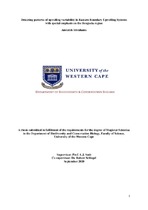Detecting patterns of upwelling variability in Eastern Boundary Upwelling Systems with special emphasis on the Benguela region
Abstract
Coastal upwelling is one of the most important oceanographic processes relating to ecosystem function at local and global spatial scales. To better understand how changes in upwelling trends may occur in the face of ongoing anthropogenically induced climate change it is important to quantify historical trends in climatic factors responsible for enabling coastal upwelling. However, a paucity of conclusive knowledge relating to patterns concerning changes in upwelling across the world’s oceans over time makes such analyses difficult. In this study I aimed to quantify these patterns by first identifying when upwelling events occur using a novel method for predictingthe behaviours of coastal upwelling systems over time. By using remotely sensed SST data of differing resolutions as well as several wind variables I was able to identify and quantify upwelling signals at several distances away from the coastline of various upwelling systems. Using this novel method of determining upwelling, I then compared upwelling patterns within all Eastern Boundary Upwelling Systems (EBUS) over a period of 37 years, with the assumption that climate change was likely to have driven variable wind patterns leading to a more intense upwelling over time. Overall, upwelling patterns and wind variables did not intensify overtime. This method of identifying upwelling may allow for the development of predictive capabilities to investigate investigate investigate upwelling trends in the future.

